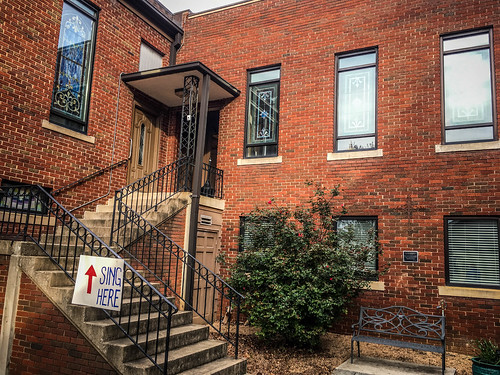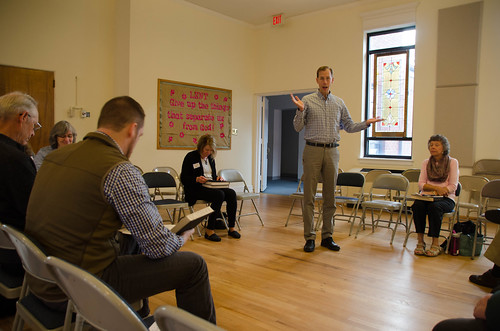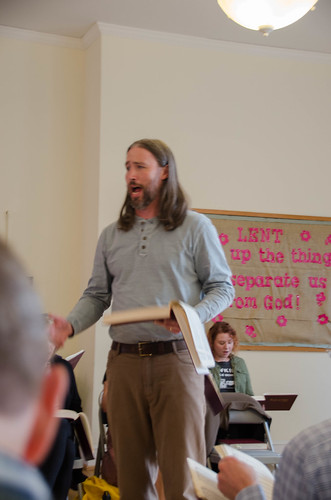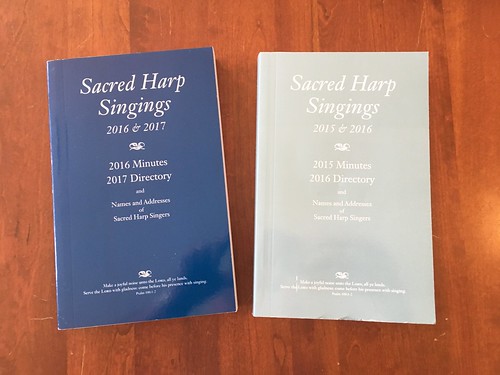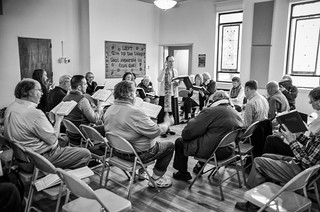I almost missed it. A friend had posted on Facebook that he was attending the William Walker Memorial Shape Note Singing and that it would be this weekend. My original plans for the weekend had been changed, so I thought it would be a good chance to head over there. It had been awhile since I’d been to one of these singings, longer than I had thought, as it turned out.
From what I can tell from my records on this site, the last time I went to the William Walker Singing was in 2009. The singings had been held on the Wofford Campus. For the past four years they at been holding the event at Second Presbyterian Church, across from Wofford. That drove home how long it had been since I’d participated.
Saturday morning I headed across to Spartanburg, armed with multiple cameras and audio recorders while also lugging my copies of The Sacred Harp and Christian Harmony. Once again I’d be walking that precarious line between participant and documentarian. One of these days I should leave all of the AV gear at home and just sing. But, that stuff is just as much a part of me as singing.
I found the church with no problem. Even though this was a new venue for me, there was no problem finding the room.
Despite my long absence from the scene I walked in to see several familiar faces. Friend and fellow singing David Farmer was setting up chairs in the traditional “open square” formation. Robert Kelley was getting ready for his introductory class. Leon and Francis Carnell were setting up sign-in sheets and loaner books. I signed in, but this time I made the decision NOT to sign up to lead. I just didn’t want to make decisions today.
To me, this new space is much better than when they held the singing at Wofford. There they had stuffed us into a carpeted, padded conference room with horrible acoustics. This was a fellowship hall with a small stage at one end and kitchen at the back. There were lots of hard surfaces for the sound to bounce around.
When I was at the Furman Singing a couple of years ago I found out that I had the wrong copy of Christian Harmony. I was told I had the “King James Version”. I picked up a loaner for the morning, but as soon as the new versions for sale arrived I went ahead and purchased one.
I took my position in the bass section. I chose a seat on the end of the row next to the tenor, or “lead” section. That way I could jump between parts if I so desired. It would also let me get up and take photos without as much disruption. I also set up two of my recorders on either side of the room. Those would run for the entire day. I wouldn’t be doing any video, but I would take still photos.
At 9:30 Robert Kelley got up and did a quick “singing school”, describing the two different shape systems used for Sacred Harp and Christian Harmony.
I was a bit worried because there were only thirteen singers so far, an unlucky number. By 10:00 more had arrived for the start of the regular singing.
We began with the Sacred Harp, which is different for this particular event. William Walker published the Southern Harmony and later the Christian Harmony, which we would be using. Normally we would start with that book and use Sacred Harp later. At least the first leader selected a song by Walker for us to start.
The singing proceeded as these events usually do, with the regulars getting up to lead their favorite songs. I would sing a verse or so then hop up to take a couple of photos.
We took a break at 11:00 and I used the opportunity to explore the church. Second Presbyterian is an architectural gem. The exterior is brick Gothic, and the interior has wonderful open wood and plaster for resonant acoustics. The wooden pews were works of art by themselves, with elaborate scroll work. It looked like they were built specifically for this sanctuary because the curved pews fit perfectly within the space.
After the break we switched to Christian Harmony. Even after all these years I still have trouble with the syllables, especially when switching between books. The shape that was once “Fa” in Sacred Harp is now “Do.” I’m an excellent sight reader, so the syllables NEVER made sense to me, though I used solflege when I was a music teacher. I just find them more of a hindrance. But, this is part of the tradition. These singings came from the Singing School tradition, so singing the syllables is part of the event as the songs themselves.
We broke for lunch, after which we did more Sacred Harp for an hour, then finished with an hour of Christian Harmony. For whatever reason it seemed that the selection of songs took on a rather morbid tone. For example, the song New Topia had this lovely phrase in the refrain…
Remember you are hastening on
To Death’s dark, gloomy shade;
Your joys on Earth will soon be done,
Your flesh in dust be laid.
“The Dying Californian” and “The Watchman’s Call” were a couple of other winners.
I have to confess, my preference is for up-tempo, happier songs. Even with the morbid themes there were a few good ones. One song I like is “Hebrew Children.” Even though it’s in a minor key the song is about the Promised Land rather than death and judgement. That’s one of those songs where I switched to lead because I like the melody. I have a good recording of the Waverly Consort singing this. A baritone sings the melody as a solo with the rest of the group coming in later. Here’s an excerpt of our group singing on Saturday…
We continued singing until 3:00. Tradition has been for several to head out to William Walker’s grave nearby to sing a couple of songs. I had finally found Walker’s grave on a recent photo outing, but I’d never participated in the singing. I was actually kind of looking forward to doing it this time, but no one else seemed to be interested. I decided I’d head on back home.
Some final thoughts…
Shape note singing is the embodiment of the corporate music making I mentioned in my earlier post. I’ve only been to a few singings, but in all the ones I’ve attended there has been no accommodation for an audience. If you’re there, you’re going to sing.
Most people I know, especially many of my choral singer friends, have a hard time listening to recordings of this music. I can’t even stand to listen to recordings. Many of them were like me – they learned about Sacred Harp through some choral arrangement of one of the songs from that source. These were probably presented in a refined concert setting or recording. When they hear the real thing they tend to be disappointed.
The point is that this is NOT a concert. You have to sing. You have to feel the raw energy and emotion of the event. You have to be there.
Those that participate in these singings do so for various reasons. Some are singers from other settings, such as David Farmer from the Greenville Chorale and music director Alan Reed. Some approach it as an academic endeavor, such as Lander professor Robert Kelley. Some come to it from an interest in folk traditions in general. For some this is an honest expression of their faith and an outgrowth of their church experience. Their reasons for attending often affect their approach to the music, and it’s fascinating to see how those reasons manifest themselves in facial expressions, etc.
I still want to attend a large singing in a historic setting, perhaps in the depths of Georgia or Alabama. I picked up copies of the past two years’ records so that I might find one of these.
From the minutes I learned that many of the Sacred Harp singings use the “Cooper Book”, and updated version of The Sacred Harp. I guess I’ll have to buy yet another book.
I used to think it would be fun to sing these in an old white frame church or meeting house. Knowing more about the traditions, I think a church is probably not appropriate. You would have to move pews, etc. A meeting house or old school would probably be a better fit.
Regardless, this was lots of fun. I’ll have to make sure I don’t let another eight years slip by before attending the next William Walker Memorial Singing.


